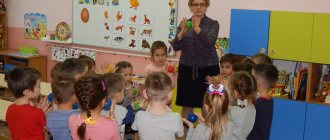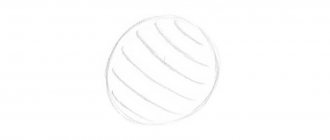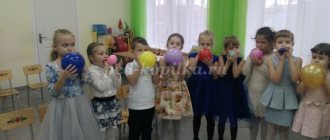Abstract of OOD on ecology in the middle group. Topic: “Acquaintance with ornamental birds.”
Abstract of OOD on ecology in the middle group.
Topic: “Acquaintance with ornamental birds.”
Tasks:
Educational: give children an idea about ornamental birds, show the features of their maintenance
Developmental: enrich children’s speech with new words (canary, pallet, feeder, drinking bowl, plumage, veterinary clinic)
Educational: to create a desire to care for living objects
Methods and techniques: Verbal (conversation, question-answer, explanation, artistic words); visual (show, demonstration); practical (exercise).
Materials and equipment: Pictures of canaries, presentation “House of the Canary”, audio recording “Singing of Ornamental Birds”, video recording “Canaries”, coloring book on the topic.
Preliminary work: conversation about birds (domestic, migratory, wintering)
Move.
1. Formation of internal motivation in children for activity.
Educator: Children, sit down on the rug, let’s close our eyes and listen carefully (the singing of decorative birds sounds).
2. Activity planning.
Educator: ... 1,2,3 open. Guys, have you guessed what we will talk about today? And to find out what we are going to talk about today, you need to guess the riddle.
They have wings and a head.
Two legs beak and feathers
Everyone comes from an egg
You can hear their songs from the trees. (Birds)
Educator: And we’ll talk about unusual and very beautiful birds! (The teacher shows a picture of a canary and asks)
Educator: Children, who knows the name of this bird? This bird is called "canary".
3. Implementation of the plan.
Educator: Today I will tell you about this amazing bird - the canary.
Canaries are small birds that were brought to us from another country from the Canary Islands, which is why they are called canaries. They sing amazingly. Do you want to hear them sing?
Children: yes, we want.
(The teacher plays a recording of canaries singing.)
Educator: Did you like the singing?
Children: Yes, very much.
Educator: Now let's look at the pictures that depict canaries.
(After looking at the pictures, the teacher asks the children)
Educator: What do you think is needed for a canary to live at home?
Children: you need to take proper care of her.
Educator: Of course, in order for a bird to live at home, first of all you need to properly care for it. I will now tell you how to properly care for birds.
— Birds are kept indoors in a cage. (Shows the children a presentation depicting an empty bird cage) The cage must be placed in a well-lit place where there are no drafts, otherwise the birds may catch a cold and get sick. The cage should have perches made of branches so that the birds can sit on them (Shows the children a presentation from a perch made of branches). The cage should also have a pull-out tray. Sand is poured into this pan. Sand needs to be changed 2-3 times a week.
Lesson notes on the world around us in the middle group. Meet the Canary
Summary of a lesson on the world around us with children in the middle group of kindergarten on the topic “Getting to know the canary.”
The outline of this lesson will be useful to teachers of middle groups of kindergartens conducting classes on the surrounding world according to the Veraksa program.
The summary is interesting because children participate in a role-playing game together with an adult and learn new information during the game. The activity encourages children to own and care for pets, which promotes their moral development. Purpose: To give children an idea of the decorative bird, the canary. Show the features of keeping ornamental birds. To develop a desire to observe and care for ornamental birds and all living creatures. Material: Presentation with photographs, fragments of a video about canaries;
empty bird cage, perch, drinking bowl, feeder. Progress of the lesson:
I play an audio recording of the song “Bird Market” for the children (Bird market, bird market, we are doing well! We are going to the bird market to buy ourselves a goldfinch!) While the children listen to the audio recording of the song, I put on a white robe and go out to the children.
Educator: Guys, today you will also go for a bird, but not to the bird market, but to the pet store. Look at this picture, do you recognize this bird? What is it called? Children: Canary. Educator: So you are going to the pet store for a canary, and I, the pet store salesperson, will meet you here. Hello guys! Children: Hello! Educator: I have a variety of ornamental birds living here. What kind of bird do you want to get? Children: Please tell us about the canary. Educator: There are a lot of birds living in my pet store. I admire them very often and listen to how amazingly they sing. Canaries are very small birds, usually yellow in color, they were brought to our country from another country called the Canary Islands, for which the bird was called a canary. I show the children photographs of the canary, a video fragment “The beautiful song of the canary” (the canary sings songs). Educator: Guys, do you want to have a canary at home? Do you know where she lives in the apartment? I am conducting a didactic game “Whose house is this?” (from the pictures laid out on the table, children choose housing for a dog, a fish, a hamster and a canary) Educator: You are right, the canary lives in a cage. What do you guys think is needed for a bird to live at your home? (children's answers) Educator: Of course, in order for a bird to live in your home, you need to properly care for it. Do you know how to properly care for a canary? Children: No. Educator: Indoors, birds are kept in a cage. The cage should be positioned so that the sun shines on it well, so that the wind does not blow there (there is no draft). Why can’t a bird live in a draft? Children: She might get sick. Educator: You are right, birds, like people, also get sick. Educator: Now, guys, let's have a little rest. Let's imagine that you and I are beautiful canaries, let's watch the video and repeat after the bird (physical education lesson, do like a bird) I show the children a cage for a canary, the perches in it). Educator: Guys, why do birds in a cage need perches? Children: To sit on them. Educator: Everything is correct. And this is a pallet, sand is poured here. Sand needs to be changed 2-3 times a week. Why do you need to change the sand in the pan? Children: To keep the cage clean. What should you feed the canary? Educator: Canaries love seeds very much. All year round, the canary needs green food: lettuce leaves, oat shoots. Fruits and vegetables are very beneficial for canaries. What fruits do you know? Children: Oranges, tangerines, apples, bananas, kiwis, pears, etc. Educator: Well done! Canaries love apples, pears, and bananas. As for vegetables, they eat fresh cucumbers, carrots, and beets. (During the story, I show the children a presentation on canary nutrition.) Educator: Food is poured into the feeder (I show the real feeder for the cage), and water is poured into the drinking bowl (I show the children the drinking bowl). Children: What else can you tell us about the canary? Educator: If you want to get a canary, then you should know that the canary is afraid of loud sounds and noise, especially when it gets used to a new place. Children: What to do if the canary gets sick? Educator: If the canary gets sick, then you need to take it to the veterinary clinic. Do you know what this is? Children: A veterinary clinic is a special hospital for animals. Educator: You are right. But you should also know that before you take your canary home, you should still take it to the veterinarian to get it vaccinated, because canaries, like people, can also get sick. And now guys, I want to check if you are ready to have a canary. Answer my questions. Where in the house will you place the canary? Children: In a cage. Educator: How will you look after her? Children: We will clean the cage and feed it. Educator: Okay. Now we’ll play the game “Feed the Canary” and I’ll see if you remember what to feed the bird. (From the cards on the table, children choose only those foods that can and should be fed to the bird). Educator: Well done! What other very important things do you need to know to get a canary? Children: It is very important to get her vaccinated! And you can't make loud noise! Educator: Guys, you are great! Now you are actually ready to get your own bird. And if you do buy a canary with your parents, try to take good care of it!
We recommend watching:
Summary of educational activities for children with parents in the middle group. Do-it-yourself doll Summary of a lesson on speech development on the topic “Toys” in the middle group Methodological development of educational activities for the development of communicative activities in children of the middle group Summary of a developmental lesson for children 6-8 years old on the topic: Time
Similar articles:
Lesson in the middle group “Winter clothes”
Math lesson notes “Number 1”. Middle group
Presentation on the topic: Decorative, song and wintering birds
Description of the slide: The nightingale He clicks, rumbles, whistles, murmurs, chirps Like a rainstorm, he bubbles, rings like a bell, Then on his fifth knee he suddenly peals, And then he plays the trills of a caring pipe - On the shore above the slope, where there is a green talnik, Where the hops have grown wild, the great artist sings. (Nightingale) The nightingale belongs to the passerine order, the thrush family. This is a small brown bird (14-17 cm). With strong and long legs, with large dark eyes. The eyes give the nightingale a special charm. The color of the feathers is brown, and the tail is red. The nightingale bird lives in Europe, Africa, Asia. The common nightingale nests in Russia, and the bluethroat in the North Caucasus. In Siberia and the Far East: ruby-throated nightingale, black-breasted ruby-throat, blue whistling nightingale. Among the songbirds of Russia, the nightingale is the most common bird. For the winter, these birds fly to warm countries. In spring, nightingales fly to their homeland at the time when grass begins to grow and leaves bloom on trees and shrubs. Having returned home, the nightingales find their old nests and begin to sing. The nightingale sings day and night. Most often, the bird's song can be heard from the thickets of lilac and alder. The best singers are considered to be the eastern and western nightingales. Nightingales are wonderful singers. And the spring song of the nightingale will penetrate the heart of any person. The bird stands high on legs spread apart, wings down and tail raised. While holding it, he often bows and sings. The nightingale's song consists of many sounds, as well as whistling, clicking and rumbling sounds. Nightingales feed on insects: ants, weevils, ground beetles, caterpillars, centipedes, flies. In autumn they prefer berries and seeds. The nightingale places its nest on the ground, near the roots of a bush, overgrowth, or in a pile of dry autumn leaves. A clutch of 4-6 eggs is olive or brown-olive, brown in color. Incubation lasts about two weeks. The chicks are fed by both parents for 12 days. At the beginning of July, the chicks leave the nests. The departure of nightingales begins from late August to September. In captivity, nightingales live a long time and sing well, although they get used to humans with some fear. The main food for birds can be a mash: hard-boiled chopped eggs, grated carrots, apples, chopped white cabbage, crushed corn, grated white crackers, cottage cheese, prunes, raisins, fruits, rowan berries. Mealworms, sprouted grains of wheat and barley should be given. Do not forget about mineral feed: river sand, crushed shell rock, crushed eggshells. Charcoal should be offered occasionally. The nightingale needs a comfortable large cage with a bush and a cup base for the nest.
Summary of educational activities in the middle group on the topic: Birds
Summary of educational activities in the middle group.
Author
: Osina Olga Anatolyevna, teacher.
Municipal budgetary educational institution of the city of Abakan “Child Development Center - kindergarten “Chaika”. Description of the material:
I offer you a summary of educational activities for children in the middle group on the topic “Little Red Riding Hood talks about birds.” This material will be useful for educators and methodologists.
Summary of educational activities.
Topic: “Little Red Riding Hood talks about birds.” Goal: creating a social situation of development in the process of cognitive activity “Little Red Riding Hood talks about birds.” Objectives: 1. Provide conditions for the development of children’s cognitive activity; 2. Provide conditions for children to express their opinions and make decisions; 3. Provide conditions for encouraging children to engage in speech activity; 4. Promote the development of peer interaction skills. Types of children's activities: communicative, perception of fiction, play, motor, music. Equipment: Little Red Riding Hood doll, pictures of wintering birds, models of birds, an envelope with riddles, an audio recording of “Bird Voices”. Progress of educational activities. Introductory part (organizational and motivational point). Educator . Guys, Little Red Riding Hood came to our group (I show the toy Little Red Riding Hood. The teacher talks to the children on behalf of the doll).
Little Red Riding Hood. I have prepared something interesting for you. Here I have an envelope with an interesting inscription: “Riddles for the guys.” Let's try to solve them. Main part. Little Red Riding Hood asks the children riddles. As the birds are named, the teacher puts the corresponding picture on the board. Puzzles. Little Red Riding Hood. She is called that for her blue wings. And in the cold and in the heat she sings so loudly. The one in the yellow shirt is really small. So what will you call her? (Titmouse).
The feathers are fluffed up and they are basking in the sun.
Here on the branches, look, in red T-shirts... (Bullfinches)
He knocks all the time, he hollows out trees, But he doesn’t cripple them, he only heals them...
(Woodpecker).
A mischievous boy in a gray army coat darts around the yard, picks up crumbs...
(Sparrow)
A fidgety motley bird, a long-tailed bird, a talkative bird, the most talkative.
(Magpie)
Grayish in color, thievish in habit, hoarse screamer - Famous person Who is she?
(Crow)
This bird, the postman, brought news into the house.
It is not without reason that she is now a symbol of peace and goodness. (Dove) Little Red Riding Hood. Tell me, what kind of birds are these? (Children's answers) Little Red Riding Hood. Right. What do these birds have in common? How are they similar? (A model of a bird is exhibited).
Reasoning, children's answers) Little Red Riding Hood. Yes, all birds have a body, a head, legs, and the body is covered with feathers. Hatch from eggs. Little Red Riding Hood. Let's play a game with you. Didactic game “Compare birds in pairs” (Pairs of birds are called, a picture depicting the named birds is shown).
A sparrow is a crow, a bullfinch is a tit, a woodpecker is a dove, a magpie is a tit.
Little Red Riding Hood. How do these birds differ from each other? Let's compare them. (Children look at the pictures. Children’s reasoning and answers). Little Red Riding Hood. Why do you think wintering birds don’t fly to warmer climes? What do birds eat in winter? (Children's answers).
Little Red Riding Hood: Do birds have enough food in winter?
How can we help birds in winter? What kind of food can be prepared for them? Where can you put food for the birds outside? (Children’s answers) Exercise “Feed the birds.” Pairs of pictures are put on the board: bullfinch - rowan berries. Tits - seeds and lard. Dove - bread crumbs, seeds. Sparrow - grains. Woodpecker - cone seeds. (Children make sentences based on the picture.) Dynamic pause. The birds flapped their wings - they flew and flew, The birds circled in the air, They landed on the road, They jumped along the path, They pecked crumbs and grains. (Children perform movements according to the text).
An audio recording of “Bird Voices” is played
(Children listen to an audio recording with the voices of birds.) Little Red Riding Hood. Did you recognize the voices of birds? Didactic game “Who is screaming?” Little Red Riding Hood. Who's croaking? Who's tweeting? Who's chirping? Who's cooing? (Children's answers) Little Red Riding Hood. Let's continue the game at the table. Guys, you need to split into pairs. Choose a friend with whom you would like to work. (Work in pairs with subject pictures). Didactic game “The fourth odd one” Bullfinch, crow, stork, woodpecker. (Stork).
Tit, magpie, sparrow, starling.
(Starling).
nightingale, pigeon, magpie, tit.
(Nightingale). (Children name pictures of birds and choose one extra one among them, explain their choice.) Summary of the lesson. Little Red Riding Hood. Well done boys! Well done. Guys, what did we do today? What did you like most? Why? What do you remember? I really enjoyed playing with you. Let's say goodbye, it's time for me.
We recommend watching:
Abstract of the educational activity in the field of "Cognition" in the middle group "Let's help friends" Abstract of the educational activity "Cognition" Mathematics in the middle group
Abstract of GCD on artistic creativity in the middle group according to the program “From birth to school” Story - essay about the friendship of birds for preschoolers
Similar articles:
A story about a duck for children, grades 1-2
Conversation on the topic “Poultry” in the preparatory group
Summary of GCD in the middle group in artistic creativity
Lesson summary on artistic and productive activities in the middle group
Summary of entertainment in the junior and middle groups



